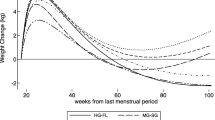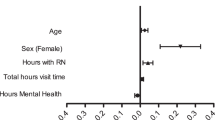Abstract
We assessed variations in and correlates of weight-loss success (WLS) among overweight/obese women in Mexico (WIMX) and Mexican–American women (MA). We used cross-national data from 2006 ENSANUT (Mexico) and NHANES (2001–2008) to compare 5061 WIMX with 550 MA’s without known metabolic conditions. WLS was defined as losing ≥5 % of body weight over 1 year. MA’s were more likely to attain WLS (OR 1.31; 95 % CI 1.01–1.70). WLS among WIMX was higher in those with at least high school, a provider screen of overweight and a lower BMI. Among MA’s, an incomplete high school versus primary education reduced the odds of WLS. Among women who lost ≥10 lbs, weight-loss strategies such as eating less were higher among MA’s. MA women were more likely than WIMX to attain WLS. Understanding these disparities can help design customized public health interventions that curb the obesity epidemic in these women in both countries.


Similar content being viewed by others
References
National Center for Health Statistics. Prevalence of overweight and obesity among adults: United States, 2003–2004. In NCHS Health E-Stats. April 2006; Edited by Centers for Disease Control and Prevention; 2006.
Flegal KM, Carroll MD, Ogden CL, Curtin LR. Prevalence and trends in obesity among US adults, 1999–2008. JAMA. 2010;303(3):235–41.
Olaiz-Fernández G, Rivera-Dommarco J, Shamah-Levy T, Rojas R, Villalpando-Hernández S, Hernández-Avila M, Sepúlveda-Amor J. Encuesta Nacional de Salud y Nutrición 2006. Cuernavaca, México: Instituto Nacional de Salud Pública; 2006. [http://www.insp.mx/images/stories/Produccion/pdf/100722_cp3.pdf].
Bersamin A, Hanni KD, Winkleby MA. Predictors of trying to lose weight among overweight and obese Mexican–Americans: a signal detection analysis. Public Health Nutr. 2009;12(1):64–73.
Institute of Medicine. Joint US–Mexico workshop on preventing obesity in children and youth of mexican origin. Summary. In: The National Academics Press; 2007. [http://www.nap.edu/catalog/11813.html].
Barquera S, Campos-Nonato I, Hernández-Barrera L, Flores M, Durazo-Arvizu R, Kanter R, et al. Obesity and central adiposity in Mexican adults: results from the Mexican National Health and Nutrition Survey 2006. Salud Publica Mex. 2009;51(suppl 4):S595–603.
Lindberg N, Stevens V, Vega-Lopez S, Kauffman T, Rosales-Calderon M, Cervantes MA. A weight-loss intervention program designed for Mexican–American women: cultural adaptation and results. J Immigr Minor Health. 2012;14(6):1030–9.
Poston WS, Reeves RS, Haddock CK, Stormer S, Balasubrma-Snyam A, Satterwhite O, et al. Weight loss in obese Mexican Americans treated for 1-year with orlistat and lifestyle modification. Int J Obes Metab Disord. 2003;27(12):1486–93.
New C, Xiao L, Ma J. Acculturation and overweight-related attitudes and behavior among obese Hispanic adults in the United States. Obesity (Silver Spring). 2013;21(11):2396–404.
Méndez-Hernández P, Dosamantes-Carrasco D, Lamure M, López-Loyo P, Hernández-Palafox C, Pineda-Perez D, Flores y Salmerón J. Weight-loss practices among university students in Mexico. Int J Public Health. 2010;55(3):221–5.
Bowie J, Hee-Soon J, Cho J, Rodriguez E. Factors associated with overweight and obesity among Mexican Americans and Central Americans: results from the 2001 California Health Interview Survey. Prev Chronic Dis. 2007;4:1–17.
Guendelman S, Ritterman-Weintraub M, Fernald L, Kaufer-Horwitz M. Weight status of Mexican immigrant women: a comparison with women in Mexico and with US-born Mexican American women. Am J Public Health. 2013;103(9):1634–40.
Willett WC, Dietz WH, Colditz GA. Guidelines for healthy weight. N Engl J Med. 1999;341(6):427–34.
Lindstrom J, Uusitupa M. Lifestyle intervention, diabetes, and cardiovascular disease. Lancet. 2008;371(9626):1731–3.
Bish C, Blanck HM, Maynard M, Serdula MD, Thompson NJ, Kettle Khan L. Health-related quality of life and weight loss practices among overweight and obese US adults, 2003 behavioral risk factor surveillance system. Med Gen Med. 2007;9(2):35–50.
United States Department of Health and Human Services. The National Health and Nutrition Examination Survey. United States Department of Health and Human Services; 2001–2006.
World Health Organization Technical Report Series 894. Obesity: preventing and managing the global epidemic. Report of a WHO Consultation. Geneva, 2000 in World Health Organization in [http://whqlibdoc.who.int/trs/WHO_TRS_894.pdf] and WHO (2010) [http://apps.who.int/bmi/index.jsp?introPage=intro_3.html].
Dorsey R, Songer T. Lifestyle behaviors and physician advice for change among overweight and obese adults with prediabetes and diabetes in the United States, 2006. Prev Chronic Dis. 2011;8 (6):A132 Epub2011 October 17.
Yaemsiri S, Slining MM, Agarwal SK. Perceived weight status, overweight diagnosis, and weight control among US adults: the NHANES 2003–2008 Study. Int J Obes (Lond). 2011;35(8):1063–70.
Moyer VA, U. S. Preventive Services Task Force. Screening for and management of obesity in adults: U.S. Preventive Task Force recommendation statement. Ann Intern Med. 2012;157(5):373–8.
Post RE, Mainous AG, Gregorie SH, et al. The influence of physician acknowledgment of patients’ weight status on patient perceptions of overweight and obesity in the United States. Arch Intern Med. 2011;171(4):316–21.
United States Preventive Service Task Force. Screening for Obesity in Adults; Recommendations and Rationale; 2003. http://www.uspreventiveservicestaskforce.org/3rduspstf/obesity/obesit.htm.
Alexander SC, Ostbye T, Pollak KL, et al. Physicians’ beliefs about discussing obesity: results from focus groups. Am J Health Promot. 2007;21(6):498–500.
Ma J, Xiao L, Yank V. Variations between obese Latinos and Whites in weight-related counseling during preventive clinical visits in the U.S. Obesity (Silver Spring). 2013;21(8):1734–41.
Agne AA, Daubert R, Munoz ML, Scarinci I, Cherrington AL. The cultural context of obesity: exploring perceptions of obesity and weight loss among Latina immigrants. J Immigr Minor Health. 2012;14(6):1063–70.
Abraído-Lanza AF, Chao MT, Flórez KR. Do healthy behaviors decline with greater acculturation? Implications for the Latino mortality paradox. Soc Sci Med. 2005;61(6):1243–55.
Ham S, Yore M, Kruger J, Heath G, Moeti R. Physical activity patterns among Latinos in the United States: Putting the pieces together. Prev Chronic Dis. 2007;4(4):A92. Epub2007 Sept 15.
Colchero MA, Sosa-Rubi SG. Heterogeneity of income and lifestyle determinants of body weight among adult women in Mexico, 2006. Soc Sci Med. 2012;75(1):120–8.
Cohen DA. Obesity and the built environment: changes in environmental cues cause energy imbalances. Int J Obes (Lond). 2008;32(suppl 7):S137–42.
Woodward-Lopez G, Flores G. Obesity in Latino Communities. Prevention, principles and action. Latino Coaltion for a Healthy California; 2006. [http://www.lchc.org/wp-content/uploads/2005_Obesity_in_Latino_Communities_NewLogo.pdf].
Gutiérrez G, Pérez-Cuevas R, Levy S, Reyes H, Acosta B, Fernández Cantón S, Muñoz O. Strengthening preventive care programs: a permanent challenge for healthcare systems; lessons from PREVENIMSS México. BMC Public Health. 2010;10:417.
Secretaría de Salud, Manual de operación para las intervenciones contra el sobrepeso y la obesidad en el marco del Acuerdo Nacional de Salud Alimentaria, México. Dirección General de Promoción de la Salud, Centro Nacional de Programas Preventivos y Control de Enfermedades (CENAPRECE); 2011. [http://www.cenaprece.salud.gob.mx/programas/interior/adulto/descargas/pdf/manualoperativoANSA.pdf].
Reininger BM, Barroso CS, Mitchell-Bennett L, Cantu E, Fernandez ME, Gonzalez DA, Chavez M, Freeberg D, McAlister A. Process evaluation and participatory methods in an obesity-prevention media campaign for Mexican–Americans. Health Promot Pract. 2010;11(3):347–57.
Weiss EC, Glauska DA, Kettel Khan I, Gillespie C, Serdula HK. Weight regain in US adults who experienced substantial weight loss, 1999–2002. Am J Prev Med. 2007;33(1):34–40.
Gillum RF, Sempos GT. Ethnic variation in validity of classification of overweight and obesity using self-reported weight and height in American women and men: The Third National Health and Nutrition Examination Survey. Nutr J. 2005;4:27–44.
Acknowledgments
This study was funded in part by the Programa de Investigación en Migración y Salud (PIMSA). The sponsor had no role in the design and conduct of the study, the collection, analysis, and interpretation of the data; or the preparation, review, or approval of the study. IRB approval was obtained from University of California Berkeley Committee for the Protection of Human Subjects and from Instituto Nacional de Ciencias Médicas y Nutrición Salvador Zubirán. We wish to thank Héctor Avila-Rosas for the helpful suggestions in defining our outcome variable, and Oscar Rubio for his helpful suggestions in defining “income”.
Author information
Authors and Affiliations
Corresponding author
Rights and permissions
About this article
Cite this article
Guendelman, S., Ritterman Weintraub, M. & Kaufer-Horwitz, M. Weight Loss Success Among Overweight and Obese Women of Mexican-Origin Living in Mexico and the United States: A Comparison of Two National Surveys. J Immigrant Minority Health 19, 41–49 (2017). https://doi.org/10.1007/s10903-015-0315-9
Published:
Issue Date:
DOI: https://doi.org/10.1007/s10903-015-0315-9




